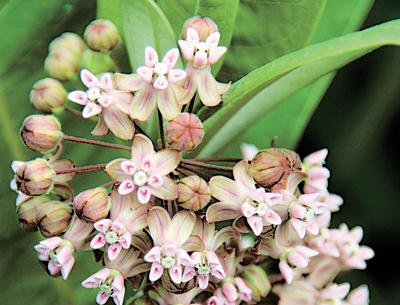Nature Notes: Pick Your Poison

It’s a jungle out there and I don’t mean New York City at night, I mean out there out here. Whether you walk in the woods or through an old field, try to catch a clam or two with your toes, or sit outside at night under the starry sky, at this time of year there is always something lurking, ready to unsettle you.
Plants don’t bite, but they can be the most menacing of all the lurkers. Poison ivy, or P.I., as it is known to campers, is one of our most common native plants and probably the most feared. I don’t get poison ivy, but I am one of a very small minority that is immune. There isn’t a native or home garden habitat around that doesn’t have a poison ivy plant or two. You can recognize it by its three shiny leaflets in a kind of rosette, but you don’t always see the leaves, and just scraping an ankle or wrist over the bare vines is enough to cause a major eruption.
Fortunately, poison ivy’s closest local relative, poison sumac, is quite uncommon and you’re not apt to find it on dry land. It’s an obligate wetland species. If you are allergic to poison ivy, then you will be even more allergic to poison sumac. One sumac looks like another and the area is loaded with sumacs of three species, but these harmless ones are all upland plants. Some, like the shining, or winged, sumac, are even grown as ornamentals in estate gardens. Stay out of swamps and you will probably never come in contact with the dangerous variety.
The stinging nettle is an attractive plant that even invites you to touch it or pick it up. I had my first stinging nettle experience when I was about 13 years old near Saratoga, upstate. It was my last because I learned quickly by way of the so-called trial and error method; I have never touched a stinging nettle since. Fortunately for us on Long Island they are very uncommon, but that may be temporary, as they are widespread in North America.
Other common local plants that can give some the itchies via contact are the native Virginia creeper and the alien but well naturalized tree-of-heaven. But wait, there is now a new kid on the block, one that can cause not only itching but very serious side effects like vomiting. It’s the giant hogweed, another alien that is rapidly becoming established on Long Island and, in the past two or three years, on the South Fork. If it’s in your neighborhood you can hardly miss it. It gets up to 10 feet tall at maturity with an umbel of small whitish flowers (not unlike the flowering head of Queen Anne’s lace, which is harmless) and its leaves are as large a rhubarb leaves. If you see it, give it a wide berth and report it to a plant person. The last ones I spied locally were on the edge of the cul-de-sac at Quarty Circle in East Hampton and on the shoulder of Daniel’s Hole Road next to Daniel’s Hole, also in East Hampton.
In order to be victimized by most of our poisonous plants, you have to ingest them. Generally, it’s the attractive fruits that are toxic, but in some, such as pokeweed, it’s the foliage. Just because catbirds and a few other fruit-eating birds are able to eat the fruit does not mean you should try it. It could make you very sick. The fruit of the deadly nightshade, a climbing vine in the tomato family, is black and iridescent, about the size of blueberries. Very tempting, but even the birds quickly learn to stay away from it.
Like the nightshade, datura, or “locoweed,” is also quite toxic, but its seeds, borne on silky thread in golf-ball sized pebbly pods developing from large white flowers, are the most so. These weeds from the Southwest kill cattle, they also make humans high (before they kill them, too). Datura comes and goes. It grows around the public ocean parking lot in Sagaponack in different years also in the fields along Route 114 north of the Long Island Rail Road tracks from time to time.
Sheep laurel is a close relative of mountain laurel. It’s a low shrub and not nearly as common as the other. Its foliage is quite poisonous and deer leave it alone. Since most of us modern humans have lost the arts of hunting and gathering, we are not likely to eat sheep laurel leaves if we come across them, and even less likely to eat the evergreen periwinkle leaves in our gardens, which are equally toxic.
And it is not very likely that we will feed on milkweeds or closely related dogbanes, the white milky sap of which would do many of us in if we ate it. You will find very few herbivores in nature eating either of these two, yet the larvae of red-and-black milkweed beetles thrive on them, as do the caterpillars of the monarch butterfly.
Mushrooms plucked from the forest floor can be very tasty and nutritious, but the flesh of a single destroying angel, Amanita phalloides, could kill an entire family. Around the world, 50 to 100 human deaths a year are attributed to eating poisonous fungi.
Then there are the blue-green algae in Mill Pond, Water Mill, and Agawam Pond in Southampton Village that we’ve been reading about, which are very poisonous to some organisms. I think I’ll pass on eating any and will confine my algae eating to sea lettuce, Ulva lactuca, fresh out of the creek.
Oh, yes, I forgot to mention goats. Curiously, they can eat poison ivy and many other poisonous plants without suffering even a faint spasm. What is it about goats? I’d like to know. Unless you’re a Capricorn, beware; it’s a jungle out there.
